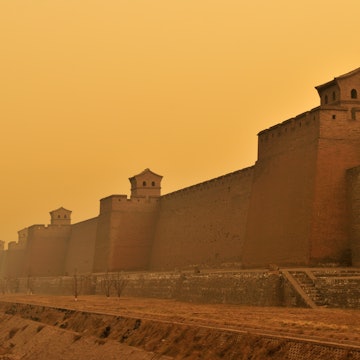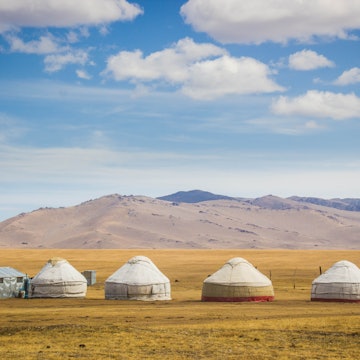

China’s most famous landmark, and one of the world's most astonishing manmade sights, the Great Wall snakes its way across northern China for over 20,000 kilometres. Its most popular sections, though easily accessible and perfectly restored, are often crowded to the point of madness. But numerous sections of the wall have been left untouched and crumbling, making for incredible, people-free hiking for the adventurous traveller.
A day of walking along a ‘wild’ section of the Great Wall, while strenuous, rewards with expansive views from overgrown, crumbling Ming-era ramparts. So if your legs are yearning for a stretch, grab your day pack and a sturdy pair of shoes and explore these spectacular sections of China’s wild Great Wall.
Ox Horn to Mutianyu

The granddaddy of wild Great Wall hikes is this strenuous, crumbling section of Jiankou Great Wall near Beijing. Completely unrestored, the wall here zigzags up a craggy mountain pass in three sections. The third section connects a steep, 180-degree turn known as the Ox Horn to Mutianyu, a restored section with sweeping views, a chairlift and a toboggan ride. Along the way, the seven kilometre hike takes in a lovely pine forest and passes several crumbling watchtowers before arriving at Mutianyu.
Time: 2-3 hours, one-way
Zhuangdaokou Village to Waterside Great Wall
Zhuangdaokou, on the outskirts of Beijing, is the starting point for this rugged walk along a completely unrestored, shrub-covered section of ‘wild’ Wall. The steepness of the hike is rewarded at the other end when you reach Waterside Great Wall (水长城; Shuǐ Chángchéng), a beautifully restored section of wall that curls around a reservoir. Along the way, the path follows alongside a river and then ascends a stony path that crumbles into a nearly impassable series of broken bastions. Once you reach Waterside Great Wall, you can pay for a ticket in to the restored section, which offers outstanding views of the water far below.
Time: 2-3 hours, one-way
Shanhaiguan to Horn Peak

Standing at 519 metres, Horn Peak (角山; Jiǎoshān) is the first mountain the Great Wall passes after rising from the Bohai Sea at the Ming garrison town of Shanhaiguan. Though many visitors head to Laolongtou, where the wall literally descends into the sea, the hike to Horn Peak is quieter and scenery-full. The hike starts at Shanghaiguan’s North Gate and, along the way, takes in a forgotten, overgrown stretch of earthen Great Wall dotted with a few leftover bricks. At the top, a ticketed restored section summits Horn Peak, but fit walkers can continue onwards to Qixian Monastery, a secluded Buddhist temple.
Time: 3-4 hours, round trip
Gubeikou

Much of the wall around Gubeikou, which has long served as a strategic mountain pass, is in complete ruin, making the hiking here both charming and challenging. There are 14 beacon towers and some 143 watchtowers along the 40-kilometre stretch of the wall that comprises Gubeikou; the most popular hiking route crosses 10 kilometres to Jinshanling, passing expansive stretches of Wall that rise and fall along the mountains as far as the eyes go.
Time: 4-5 hours, one-way
Shandan

Perhaps the most inspiring Great Wall vistas are the packed earth mounds that stretch hundreds of kilometres across the Gobi Desert in China’s far northwest provinces. Shandan Great Wall (山丹长城; Shāndān Chángchéng) in Gansu province incorporates portions built during the Han Dynasty, some 2,000 years ago. Erosion and material looting have taken their toll on many parts of the wall here, which is often little more than a red dirt precipice or a rounded collection of clay mounds that were once giant watchtowers. A hike here is not as steep as the unrestored sections of the eastern Ming walls near Beijing, but takes in expanses of desert and sky that bring out the ancient and epic nature of the Great Wall in spades.
Time: Varies, a round-trip from Shandan County can be a full-day affair
Staying safe
Unrestored sections of the Great Wall are just that: there are no safety features and in places, the wall is quite literally crumbling and overgrown. It goes without saying that taking a wild hike along the Great Wall is done at your own risk. You should prepare well, packing plenty of food and water.
Conditions can be quite treacherous in some areas where the wall hasn’t been restored, meaning you’ll need excellent hiking boots, a good sense of balance and a lot of caution when scaling particularly steep portions.
It also must be pointed out that many unrestored sections of the Great Wall are not technically open to the public, though rarely policed. In fact, wild hiking on the Great Wall is quite common, with local tour companies running guided treks, some of them overnight. Investing in a local guide or joining this type of tour can be an excellent way to experience a wild Great Wall hike with less risk.
Finally, as with hiking anywhere in the world, it’s incredibly important to have a minimal impact on the environment, especially in places where the wall has not been restored or is under threat, such as the far northwest. Environmental and heritage-site awareness is slowly gaining ground in China, but sustainability has yet to take hold with many local populations living right near the Great Wall, which means it remains at risk.
China’s most famous landmark, and one of the world's most astonishing manmade sights, the Great WallGreat Wall. snakes its way across northern China for over 20,000 kilometres. Its most popular sections, though easily accessible and perfectly restored, are often crowded to the point of madness. But numerous sections of the wall have been left untouched and crumbling, making for incredible, people-free hiking for the adventurous traveller.














